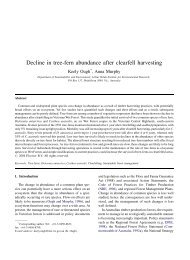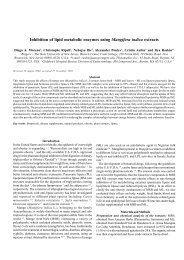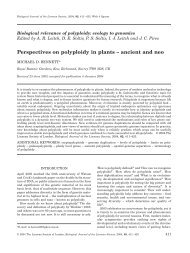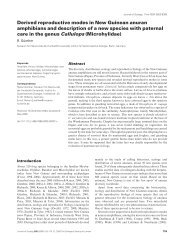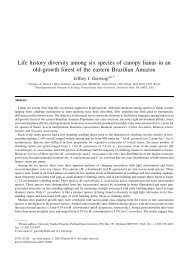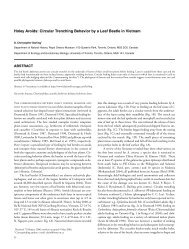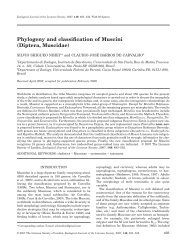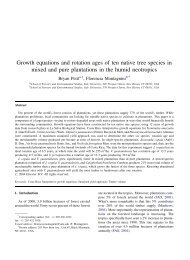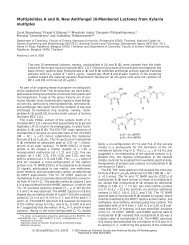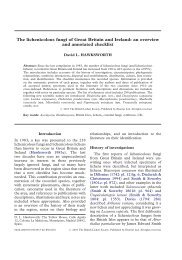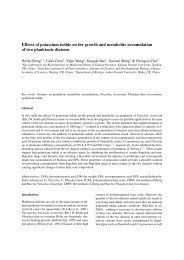Frequency of Cyanogenesis in Tropical Rainforests of Far North ...
Frequency of Cyanogenesis in Tropical Rainforests of Far North ...
Frequency of Cyanogenesis in Tropical Rainforests of Far North ...
You also want an ePaper? Increase the reach of your titles
YUMPU automatically turns print PDFs into web optimized ePapers that Google loves.
herbivores over a period <strong>of</strong> time. They screened fresh and<br />
herbarium specimens <strong>of</strong> a significant proportion (65 %) <strong>of</strong><br />
the flora from the Archipelago, and reported 81% <strong>of</strong><br />
endemic species, and 53 % <strong>of</strong> native species—those<br />
which also occur on the South American ma<strong>in</strong>land—to<br />
be cyanogenic. Interest<strong>in</strong>gly, they also reported a further<br />
22 % <strong>of</strong> native species and 30 % <strong>of</strong> endemic species to<br />
release cyanide <strong>in</strong> the presence <strong>of</strong> a crude mix <strong>of</strong> b-<br />
glycosidases (<strong>in</strong>clud<strong>in</strong>g 5 % b-glucuronidase from snails),<br />
suggest<strong>in</strong>g that a large number <strong>of</strong> species conta<strong>in</strong> cyanogenic<br />
glycosides but lack the catabolic b-glycoside enzyme.<br />
This contrasts with the f<strong>in</strong>d<strong>in</strong>gs <strong>of</strong> several other studies<br />
where the addition <strong>of</strong> non-specific b-glycosidases or<br />
pect<strong>in</strong>ase dur<strong>in</strong>g qualitative test<strong>in</strong>g did not alter the frequency<br />
<strong>of</strong> positive results (e.g. Petrie, 1912; Thomsen<br />
and Brimer, 1997; Buhrmester et al., 2000; Lewis and<br />
Zona, 2000; but see Conn et al., 1985). Similarly, <strong>in</strong> this<br />
study, all samples were spontaneously cyanogenic without<br />
the addition <strong>of</strong> pect<strong>in</strong>ase from Rhizopus spp., <strong>in</strong>dicat<strong>in</strong>g<br />
that non-cyanogenic <strong>in</strong>dividuals probably lacked both the<br />
cyanogenic glycoside and b-glycosidase, or possibly that<br />
pect<strong>in</strong>ase was not able to catalyse the cyanogenesis <strong>in</strong> these<br />
species. It is perhaps noteworthy that the greater frequency<br />
<strong>of</strong> cyanogenesis reported by Conn et al. (1985) <strong>in</strong> response<br />
to the addition <strong>of</strong> b-glycosidase (emuls<strong>in</strong>) was <strong>in</strong> a survey<br />
solely <strong>of</strong> the genus Acacia, <strong>in</strong>dicat<strong>in</strong>g that such a response<br />
may vary among taxa.<br />
It is important to note that the frequencies reported <strong>in</strong><br />
all <strong>of</strong> these surveys were apparently based on the test<strong>in</strong>g <strong>of</strong><br />
s<strong>in</strong>gle specimens <strong>of</strong> the vast majority <strong>of</strong> species (Adsersen<br />
et al., 1988; Thomsen and Brimer, 1997; Mali and Borges,<br />
2003). Similarly, while the present study aimed to test at<br />
least three <strong>in</strong>dividuals <strong>of</strong> each species <strong>in</strong> duplicate (i.e. with<br />
and without added enzyme), only one <strong>in</strong>dividual <strong>of</strong> many<br />
species was encountered (Appendix). Furthermore most<br />
species here were also tested <strong>in</strong> both wet and dry seasons.<br />
A range <strong>of</strong> studies report variable positive and negative test<br />
results among sample sizes as small as n = 2 (e.g. Kaplan<br />
et al., 1983; Thomsen and Brimer, 1997). Given such polymorphism<br />
for cyanogenesis (see also Aikman et al., 1996),<br />
the reported frequencies <strong>in</strong> these surveys may underestimate<br />
overall the actual proportion <strong>of</strong> cyanogenic species <strong>in</strong> plant<br />
communities. The reported frequency <strong>of</strong> cyanogenesis may<br />
also vary with the plant part tested. In the Costa Rican study,<br />
Thomsen and Brimer (1997) reported a greater frequency <strong>of</strong><br />
cyanogenesis among reproductive plant parts than leaves,<br />
as did Buhrmester et al. (2000) <strong>in</strong> populations <strong>of</strong> Sambucus<br />
canadensis (elderberry) <strong>in</strong> Ill<strong>in</strong>ois. Consistent with that<br />
trend, <strong>in</strong>dividuals <strong>of</strong> species with weakly cyanogenic leaves,<br />
<strong>in</strong>clud<strong>in</strong>g some which produced negative FA paper results,<br />
had higher concentrations <strong>of</strong> glycosides <strong>in</strong> flowers or fruits;<br />
however, overall, only a small number <strong>of</strong> reproductive<br />
tissues were tested, so limited comparison can be drawn<br />
(Table 1).<br />
The frequency <strong>of</strong> cyanogenesis varies between<br />
taxonomic groups and with life form. <strong>Cyanogenesis</strong> is considered<br />
especially common <strong>in</strong> some plant families (e.g.<br />
Rosaceae, Euphorbiaceae, Passifloraceae and Proteaceae;<br />
Lechtenberg and Nahrstedt, 1999), and rare or absent <strong>in</strong><br />
others (e.g. Lauraceae and Araliaceae; Gibbs, 1974;<br />
Hegnauer, 1989), a trend which may <strong>in</strong> part reflect differential<br />
<strong>in</strong>tensity <strong>of</strong> test<strong>in</strong>g among taxonomic groups. In this<br />
study, the frequency <strong>of</strong> cyanogenesis among the dom<strong>in</strong>ant<br />
plant families varied. In the Proteaceae family, five <strong>of</strong><br />
20 (25 %) species were cyanogenic, while two <strong>of</strong> 29<br />
(69 %) species <strong>in</strong> the Sap<strong>in</strong>daceae, and one <strong>of</strong> 39 (25%)<br />
species <strong>in</strong> the Lauraceae were cyanogenic (Table 1). In a<br />
screen<strong>in</strong>g <strong>of</strong> Australian Acacia, 69 % <strong>of</strong> 360 species were<br />
cyanogenic (Conn et al., 1985). <strong>Cyanogenesis</strong> appears to be<br />
rare among palms; only two species (12 %) <strong>of</strong> 155 species<br />
<strong>of</strong> palms (108 genera) were found to be cyanogenic<br />
(Lewis and Zona, 2000). No cyanogenic palm species<br />
were identified <strong>in</strong> this study.<br />
Concentrations <strong>of</strong> cyanogenic glycosides<br />
Several <strong>of</strong> the 18 cyanogenic species detected <strong>in</strong> this<br />
study conta<strong>in</strong>ed concentrations <strong>of</strong> cyanogenic glycosides<br />
among the highest reported for leaves <strong>of</strong> woody species.<br />
Most notably, tree species E. sericopetalus, C. grayi and P.<br />
turneriana had foliar concentrations <strong>of</strong> cyanogenic glycosides<br />
up to 52, 49 and 48mgCNg –1 d. wt, respectively<br />
(Table 1). Similarly, Webber (1999) recorded concentrations<br />
up to 5 mg CN g –1 d. wt <strong>in</strong> the tree species R. javanica;<br />
<strong>in</strong>dividuals <strong>of</strong> that species occurr<strong>in</strong>g with<strong>in</strong> the survey<br />
area <strong>of</strong> this study had a lower mean concentration <strong>of</strong><br />
18mgCN g –1 d. wt (Table 1). These high concentrations<br />
are substantially greater than the majority <strong>of</strong> values reported<br />
for foliage from a range <strong>of</strong> tropical and temperate taxa. For<br />
example, concentrations up to 11 mg HCN g –1 d. wt were<br />
reported <strong>in</strong> the tropical shrub Turnera ulmifolia (Shore<br />
and Obrist, 1992; Schappert and Shore, 1999), while the<br />
highest concentrations <strong>in</strong> naturally occurr<strong>in</strong>g populations <strong>of</strong><br />
Australian Eucalyptus spp. were 259 mg CN g –1 d. wt and<br />
316 mg CN g –1 d. wt for E. cladocalyx and E. yarraensis,<br />
respectively (Gleadow and Woodrow, 2000a; Goodger<br />
and Woodrow, 2002). Foliar concentrations <strong>of</strong> between<br />
166 and 378 mg HCN g 1 d. wt have been recorded <strong>in</strong><br />
cultivated Prunus spp. (Santamour, 1998). To our knowledge,<br />
possibly the highest foliar cyanogenic glycoside<br />
concentration among naturally occurr<strong>in</strong>g woody species<br />
was reported <strong>in</strong> the tropical proteaceous species Panopsis<br />
costaricensis by Thomsen and Brimer (1997), who measured<br />
2150 mg HCN kg –1 f. wt (approximately equivalent to<br />
72 mg HCN g 1 d. wt us<strong>in</strong>g a conversion based on the mean<br />
foliar water content <strong>of</strong> several species <strong>in</strong> this study, which<br />
was 70 %). The age <strong>of</strong> the leaves analysed was not specified,<br />
however, and it should also be noted that this value was<br />
determ<strong>in</strong>ed us<strong>in</strong>g picrate papers and reflectrometry, a less<br />
dependable method more sensitive to the presence <strong>of</strong><br />
<strong>in</strong>terfer<strong>in</strong>g substances (Br<strong>in</strong>ker and Seigler, 1989).<br />
Assess<strong>in</strong>g the ecological significance <strong>of</strong> the range<br />
<strong>of</strong> cyanogenic glycoside concentrations recorded here is<br />
difficult. While the high concentrations <strong>in</strong> several species<br />
(e.g. >2mgCNg 1 d. wt; Table 1) would almost certa<strong>in</strong>ly<br />
constitute toxic levels important <strong>in</strong> defence—plants with<br />
>600 mg HCN g 1 d. wt are considered potentially dangerous<br />
to livestock, for example (Hask<strong>in</strong>s et al., 1987)—the<br />
ecological significance <strong>of</strong> lower concentrations (e.g. approx.<br />
8–50 mgCNg 1 d. wt) is harder to determ<strong>in</strong>e. This reflects



